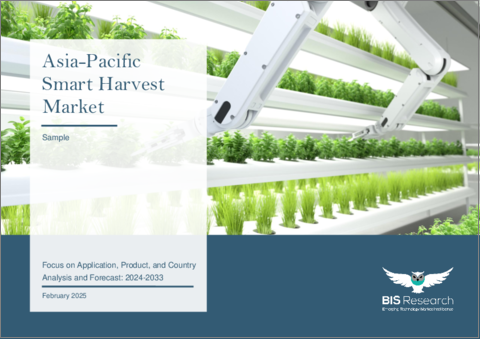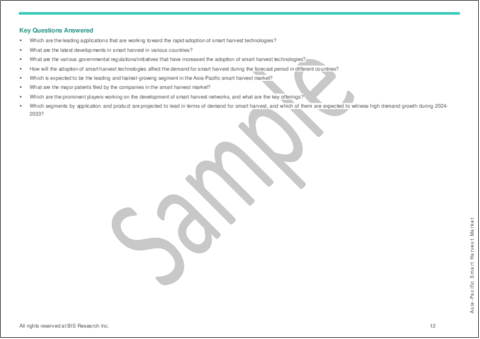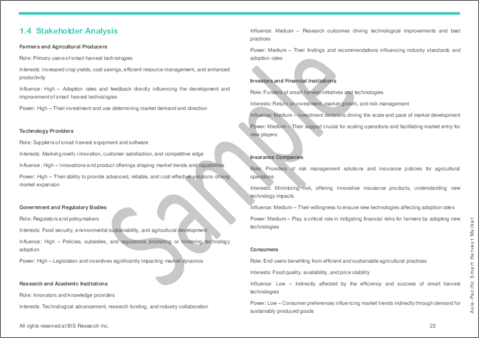|
|
市場調査レポート
商品コード
1661675
アジア太平洋地域のスマートハーベスト市場:用途・製品・国別の分析・予測 (2024-2033年)Asia-Pacific Smart Harvest Market: Focus on Application, Product, and Country - Analysis and Forecast, 2024-2033 |
||||||
カスタマイズ可能
|
|||||||
| アジア太平洋地域のスマートハーベスト市場:用途・製品・国別の分析・予測 (2024-2033年) |
|
出版日: 2025年02月26日
発行: BIS Research
ページ情報: 英文 70 Pages
納期: 1~5営業日
|
全表示
- 概要
- 図表
- 目次
アジア太平洋地域のスマートハーベストの市場規模は、2024年の14億3,000万米ドルから、予測期間中は11.39%のCAGRで推移し、2033年には37億8,000万米ドルの規模に達すると予測されています。
持続可能な農業への注目と最先端の農業技術の迅速な導入が、アジア太平洋地域のスマートハーベスト市場を大きく成長させると予想されています。収穫プロセスの精度と効率は、AIと機械学習の進歩によって改善されつつあります。スマート農業と食糧安全保障を支援する強固な政府プログラムは、革新的なソリューションへの大規模な投資を促進しています。このため、同分野の主要企業が環境持続可能性、生産性、資源効率を向上させる最先端技術を生み出し、市場は常に変化しています。このような環境の変化に伴い、スマートハーベスト技術はアジア太平洋地域の農業近代化にとって不可欠なものとなっています。
| 主要市場統計 | |
|---|---|
| 予測期間 | 2024-2033年 |
| 2024年評価 | 14億3,000万米ドル |
| 2033年予測 | 37億8,000万米ドル |
| CAGR | 11.39% |
持続可能な農法への需要の高まりと最先端の農業技術の採用拡大が、アジア太平洋地域のスマートハーベスト市場の顕著な拡大を牽引しています。同地域では、人口増加と食糧需要の増加に対応するため、自動化と精密農業による農業効率の向上に注力しています。AIを搭載したロボット収穫機、IoTに基づく監視システム、データ駆動型分析などのスマート収穫技術は、生産性を高め、労働力への依存を減らし、収穫後のロスを最小限に抑えることで、従来の収穫作業に革命をもたらしています。
食料安全保障と持続可能性を保証するため、アジア太平洋地域諸国 (特に中国、インド、日本) における政府の取り組みは、スマート農業ソリューションを極めて重要なものとしています。市場の拡大は、農業技術新興企業への投資や、農家と技術プロバイダーとの提携によっても加速しています。さらに、機械学習と高度なセンサーの統合により、作物の状態をリアルタイムで監視し、収穫サイクルを最適化し、収穫物の品質を向上させることが可能になっています。
スマートハーベストソリューションは、資源の制約や環境への懸念が高まるにつれて広く利用されるようになり、従来の技術に代わる手頃な価格で環境に配慮した代替手段を提供すると予想されています。アジア太平洋地域スマートハーベスト市場は、継続的な技術の進歩と奨励政策によって農業業界を変革し、地域全体の農家の生産性の向上し、資源管理を改善し、収益性の向上を保証します。
当レポートでは、アジア太平洋地域のスマートハーベストの市場を調査し、主要動向、市場影響因子の分析、法規制環境、技術開発・特許の動向、ケーススタディ、市場規模の推移・予測、各種区分・主要国別の詳細分析、競合情勢、主要企業のプロファイルなどをまとめています。
市場の分類
セグメンテーション1:運用サイト別
- 露地
- 管理環境
- 温室
- 屋内農場
セグメンテーション2:作物タイプ別
- 穀物
- 果物・野菜
- その他
セグメンテーション3:製品別
- ロボットハーベスター
- スマートハーベスター
- 自走式
- トラクター搭載型
- 収穫のダイナミックモニタリング
セグメンテーション4:国別
- 日本
- インド
- 中国
- 韓国
- その他
目次
エグゼクティブサマリー
範囲と定義
第1章 市場
- 動向:現在および将来の影響評価
- サプライチェーンの概要
- バリューチェーン分析
- マーケットマップ
- 価格予測
- 研究開発レビュー
- 特許出願動向 (国別・企業別)
- ステークホルダー分析
- 使用事例
- 市場力学:概要
- 市場促進要因
- 市場抑制要因
- 市場機会
- 主要製品のアーキテクチャ/技術比較
第2章 地域
- 地域別概要
- 推進因子・抑制因子
- アジア太平洋
- 地域概要
- 市場成長の原動力
- 市場課題
- 用途
- 製品
- 中国
- 日本
- 韓国
- インド
- その他
第3章 市場:競合ベンチマーキングと企業プロファイル
- 次なるフロンティア
- 地理的評価
第4章 調査手法
List of Figures
- Figure 1: Asia-Pacific Smart Harvest Market (by Site of Operation), $Million, 2024, 2028, and 2033
- Figure 2: Asia-Pacific Smart Harvest Market (by Crop Type), $Million, 2024, 2028, and 2033
- Figure 3: Asia-Pacific Smart Harvest Market (by Product), $Million, 2024, 2028, and 2033
- Figure 4: Smart Harvest Market, Recent Developments
- Figure 5: Supply Chain and Risks within the Supply Chain
- Figure 6: Smart Harvest Market, Pricing Snapshot, by Product, $/Unit, 2024, 2028, and 2033
- Figure 7: Patent Analysis (by Country), January 2021 and December 2023
- Figure 8: Patent Analysis (by Company), January 2021 and December 2023
- Figure 9: China Smart Harvest Market, $Million, 2023-2033
- Figure 10: Japan Smart Harvest Market, $Million, 2023-2033
- Figure 11: South Korea Smart Harvest Market, $Million, 2023-2033
- Figure 12: India Smart Harvest Market, $Million, 2023-2033
- Figure 13: Rest-of-Asia-Pacific Smart Harvest Market, $Million, 2023-2033
- Figure 14: Strategic Initiatives, 2021-2023
- Figure 15: Share of Strategic Initiatives, 2021-2023
- Figure 16: Data Triangulation
- Figure 17: Top-Down and Bottom-Up Approach
- Figure 18: Assumptions and Limitations
List of Tables
- Table 1: Market Snapshot
- Table 2: Smart Harvest Market, Opportunities across Regions
- Table 3: Impact Analysis of Market Navigating Factors, 2023-2033
- Table 4: Technical Parameters Comparison for Smart Harvesters
- Table 5: Smart Harvest Market (by Region), $Million, 2023-2033
- Table 6: Asia-Pacific Smart Harvest Market (by Site of Operation), $Million, 2023-2033
- Table 7: Asia-Pacific Smart Harvest Market (by Crop Type), $Million, 2023-2033
- Table 8: Asia-Pacific Smart Harvest Market (by Product), $Million, 2023-2033
- Table 9: China Smart Harvest Market (by Site of Operation), $Million, 2023-2033
- Table 10: China Smart Harvest Market (by Crop Type), $Million, 2023-2033
- Table 11: China Smart Harvest Market (by Product), $Million, 2023-2033
- Table 12: Japan Smart Harvest Market (by Site of Operation), $Million, 2023-2033
- Table 13: Japan Smart Harvest Market (by Crop Type), $Million, 2023-2033
- Table 14: Japan Smart Harvest Market (by Product), $Million, 2023-2033
- Table 15: South Korea Smart Harvest Market (by Site of Operation), $Million, 2023-2033
- Table 16: South Korea Smart Harvest Market (by Crop Type), $Million, 2023-2033
- Table 17: South Korea Smart Harvest Market (by Product), $Million, 2023-2033
- Table 18: India Smart Harvest Market (by Site of Operation), $Million, 2023-2033
- Table 19: India Smart Harvest Market (by Crop Type), $Million, 2023-2033
- Table 20: India Smart Harvest Market (by Product), $Million, 2023-2033
- Table 21: Rest-of-Asia-Pacific Smart Harvest Market (by Site of Operation), $Million, 2023-2033
- Table 22: Rest-of-Asia-Pacific Smart Harvest Market (by Crop Type), $Million, 2023-2033
- Table 23: Rest-of-Asia-Pacific Smart Harvest Market (by Product), $Million, 2023-2033
- Table 24: Market Share, Robotic Harvester Manufacturers, 2023
- Table 25: Market Share, Smart Harvester Manufacturers, 2023
Introduction to Asia-Pacific Smart Harvest Market
The Asia-Pacific smart harvest market is projected to reach $3.78 billion by 2033 from $1.43 billion in 2024, growing at a CAGR of 11.39% during the forecast period 2024-2033. The focus on sustainable farming and the quick uptake of cutting-edge agricultural technologies in the region are expected to propel the APAC Smart Harvest Market to significant growth. The precision and efficiency of harvesting processes are being improved by advances in AI and machine learning. Robust government programs that support smart farming and food security are driving large investments in innovative solutions. Because of this, the market is constantly changing as major players in the sector create cutting-edge technologies to improve environmental sustainability, productivity, and resource efficiency. With this changing environment, smart harvest technologies are becoming essential to APAC's agricultural modernization.
Market Introduction
| KEY MARKET STATISTICS | |
|---|---|
| Forecast Period | 2024 - 2033 |
| 2024 Evaluation | $1.43 Billion |
| 2033 Forecast | $3.78 Billion |
| CAGR | 11.39% |
The growing demand for sustainable farming methods and the growing adoption of cutting-edge agricultural technologies are driving the APAC smart harvest market's notable expansion. The area is concentrating on increasing agricultural efficiency through automation and precision farming in response to the region's expanding population and rising food demand. By increasing productivity, decreasing reliance on labor, and minimizing post-harvest losses, smart harvest technologies-such as AI-powered robotic harvesters, Internet of Things-based monitoring systems, and data-driven analytics-are revolutionizing conventional harvesting practices.
In order to guarantee food security and sustainability, government initiatives in APAC nations-especially in China, India, and Japan-are vitally advancing smart farming solutions. Market expansion is also being accelerated by investments in agri-tech startups and partnerships between farmers and technology providers. Additionally, the integration of machine learning and advanced sensors is enabling real-time monitoring of crop conditions, optimizing harvest cycles, and improving yield quality.
Smart harvesting solutions are anticipated to become widely used as resource constraints and environmental concerns increase, providing affordable and environmentally responsible substitutes for traditional techniques. The APAC Smart Harvest Market is set to transform the agriculture industry with ongoing technological advancements and encouraging policies, guaranteeing increased productivity, better resource management, and increased profitability for farmers throughout the region.
Market Segmentation:
Segmentation 1: by Site of Operation
- On Field
- Controlled Environment
- Greenhouses
- Indoor Farms
Segmentation 2: by Crop Type
- Grain Crops
- Fruits and Vegetables
- Others
Segmentation 3: by Product
- Robotic Harvester
- Smart Harvester
- Self-Propelled
- Tractor Mounted
- Harvest Dynamic Monitoring
Segmentation 4: by Country
- Japan
- India
- China
- South Korea
- Rest-of-Asia-Pacific
How can this report add value to an organization?
Product/Innovation Strategy: This report provides a comprehensive product/innovation strategy for the Asia-Pacific smart harvest market, identifying opportunities for market entry, technology adoption, and sustainable growth. It offers actionable insights, helping organizations leverage smart harvest to meet environmental standards, gain a competitive edge, and capitalize on the increasing demand for eco-friendly solutions in agriculture.
Growth/Marketing Strategy: This report offers a comprehensive growth and marketing strategy designed specifically for the Asia-Pacific smart harvest market. It presents a targeted approach to identifying specialized market segments, establishing a competitive advantage, and implementing creative marketing initiatives aimed at optimizing market share and financial performance. By harnessing these strategic recommendations, organizations can elevate their market presence, seize emerging prospects, and efficiently propel revenue expansion.
Competitive Strategy: This report crafts a strong competitive strategy tailored to the Asia-Pacific smart harvest market. It evaluates market rivals, suggests methods to stand out, and offers guidance for maintaining a competitive edge. By adhering to these strategic directives, companies can position themselves effectively in the face of market competition, ensuring sustained prosperity and profitability.
Table of Contents
Executive Summary
Scope and Definition
1 Markets
- 1.1 Trends: Current and Future Impact Assessment
- 1.1.1 Trends: Current and Future Impact Assessment
- 1.1.1.1 Advancements in Satellite Imaging Technologies to Forecast Harvest Yield and Potential Disruptions
- 1.1.1.2 Introduction of Agriculture 4.0
- 1.1.1 Trends: Current and Future Impact Assessment
- 1.2 Supply Chain Overview
- 1.2.1 Value Chain Analysis
- 1.2.2 Market Map
- 1.2.2.1 Smart Harvest Market- by Product
- 1.2.2.1.1 Robotic Harvester
- 1.2.2.1.2 Smart Harvester
- 1.2.2.1.3 Harvest Dynamic Monitoring
- 1.2.2.1 Smart Harvest Market- by Product
- 1.2.3 Pricing Forecast
- 1.3 Research and Development Review
- 1.3.1 Patent Filing Trend (by Country and Company)
- 1.4 Stakeholder Analysis
- 1.4.1 Use Case
- 1.4.1.1 Use Case Examination:
- 1.4.1.1.1 Feil Agriculture & Service
- 1.4.1.1.2 Automation of Crop Yield Assessment:
- 1.4.1.1.3 Flaskamp Contracting Business
- 1.4.1.1.4 Deere & Company X9 Combine - Working Smarter, Not Harder
- 1.4.1.1.5 Deere & Company X9 1000 Combine - Revolutionizing Smart Harvest
- 1.4.1.1.6 Deere & Company X9 1000 Combine - Enhancing Harvest Efficiency in Crystal Brook
- 1.4.1.1.7 Deere & Company Operations Center - Empowering Data-Driven Decisions
- 1.4.1.1.8 Augmenta NVRA - Enhancing Efficiency in the Smart Harvest Market
- 1.4.1.1.9 Analyst View
- 1.4.1.1 Use Case Examination:
- 1.4.1 Use Case
- 1.5 Market Dynamics: Overview
- 1.5.1 Market Drivers
- 1.5.1.1 Need for Maximizing Productivity While Reducing Labor Costs and Human Effort
- 1.5.1.2 Increasing Adoption of Autonomous Harvesting Equipment and Integration of Sensors and Drones
- 1.5.1.3 Rising Crop Losses Caused by Improper Harvesting Practices
- 1.5.2 Market Restraints
- 1.5.2.1 High-Cost Factor Hindering the Growth of the Market
- 1.5.2.2 Slow Rate of Adoption in Developing Countries
- 1.5.3 Market Opportunities
- 1.5.3.1 Government Initiatives to Promote Sustainable Agriculture and Food Security
- 1.5.3.2 Introduction of Scalable Harvesting Technologies for Small Scale Farms
- 1.5.1 Market Drivers
- 1.6 Architectural/Technical Comparison of Key Products in the Market
2 Regions
- 2.1 Regional Summary
- 2.2 Drivers and Restraints
- 2.3 Asia-Pacific
- 2.3.1 Regional Overview
- 2.3.2 Driving Factors for Market Growth
- 2.3.3 Factors Challenging the Market
- 2.3.4 Application
- 2.3.5 Product
- 2.3.6 China
- 2.3.6.1 Application
- 2.3.6.2 Product
- 2.3.7 Japan
- 2.3.7.1 Application
- 2.3.7.2 Product
- 2.3.8 South Korea
- 2.3.8.1 Application
- 2.3.8.2 Product
- 2.3.9 India
- 2.3.9.1 Application
- 2.3.9.2 Product
- 2.3.10 Rest-of-Asia-Pacific
- 2.3.10.1 Application
- 2.3.10.2 Product
3 Markets - Competitive Benchmarking & Company Profiles
- 3.1 Next Frontiers
- 3.2 Geographic Assessment
4 Research Methodology
- 4.1 Data Sources
- 4.1.1 Primary Data Sources
- 4.1.2 Secondary Data Sources
- 4.1.3 Data Triangulation
- 4.2 Market Estimation and Forecast





